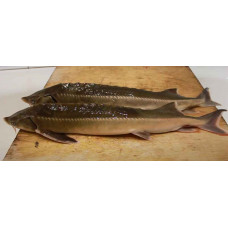Bester (from the first syllables of the words beluga and sterlet).
A hybrid obtained by artificial crossing of Beluga with Sterlet (1952). It inherited the rapid growth of the Beluga and the early maturation of the Sterlet. It is prolific, fast growing and reaches a weight of 30 kg or more.
First obtained in 1952 by Prof. Nikolukin N.I. and Timofeeva N.A. at the Teplovsky Fish Hatchery, Saratov Region. Length up to 1.8 m. In aquaculture, first generation hybrids reach a weight of 1 kg or more after 2 years of breeding in cages and pools. Related forms: beluga bester and sterlet bester.
There are 5 rows of bony bugs: 1 dorsal, 2 lateral and 2 ventral. The lateral scales are 51-52. The snout is rounded in section. There are two pairs of slightly flattened antennae, like those of the beluga, sometimes slightly wavy or serrate at the end; leaf appendages and frons are absent. Spiracles well developed. Gill membranes fused with intergingival space, forming a slightly visible fold in place of the adduction. Mouth shape intermediate between that of the beluga (semilunar) and the sterlet (transverse). The dorsal fin has 51-54 rays; anal 28-30; gill rakers 17-20 on the 1st arch. Colouration varies from sterlet to beluga, from light grey to black, light brown to greyish brown and brown. There is usually a sharp contrast between the dark dorsal and pale ventral parts of the body.
It is farmed commercially in Russia, Germany, Poland, Italy, the USA, Japan, China, South Korea and other countries. Bester must not be released into waters where natural populations of sturgeon exist because of the risk of genetic contamination of pure sturgeon species, primarily beluga.
Bester is tolerant of water salinity (0 to 18%). It can tolerate temperatures up to 34°C if the water is well oxygenated. The optimum rearing temperature is 20-25°C. Breeding is artificial only. Sexual products (eggs and milk) are usually obtained by in vitro methods during the winter-spring period, from February to June (depending on water temperature). The fecundity of the female best is 100 to 300 thousand eggs, that of the beluga best 200 to 500 thousand eggs and that of the sterlet best 20 to 100 thousand eggs. Males reach sexual maturity at the age of 4-5 years, while females reach sexual maturity at the age of 5-9 years for beluga bester and sterlet bester. The beluga bester matures slightly later: males at 8-9 years and females at 9-14 years. The beluga bester grows to 63 kg with a length of 230 cm and the sterlet bester to 10 kg with a length of 110 cm. The larvae begin to feed actively during the first 3-5 days on zooplankton, small chironomids and artificial pellets. The adult diet consists of small fish and pelleted food.
It is an important target for aquaculture. Like all sturgeons, it is considered a delicacy. The delicious meat is eaten boiled and steamed and is used to make cured fillets. Bester caviar is equal in size and taste to sturgeon and starred sturgeon caviar.
Bester
Tags: Bester



